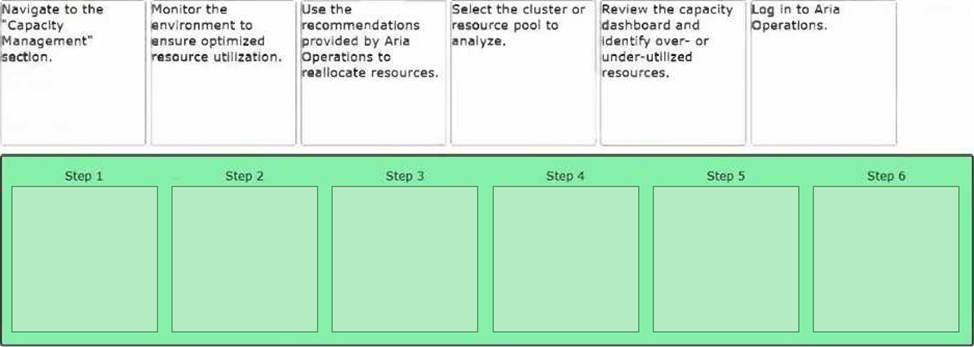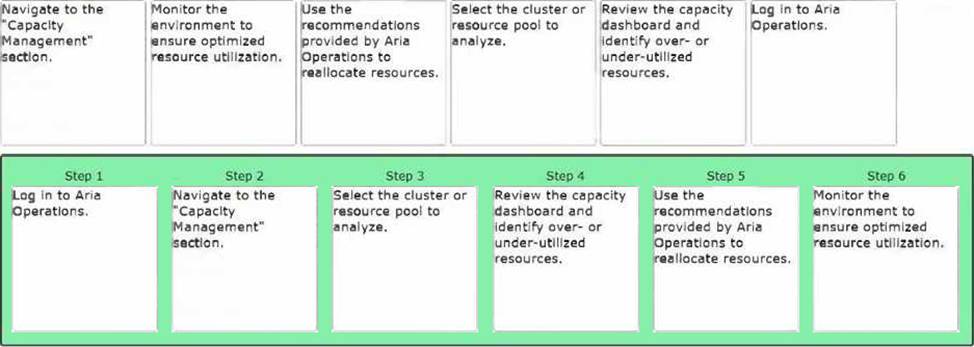Practice Free 2V0-11.24 Exam Online Questions
An administrator is deploying an NSX Edge cluster from SDDC Manager. The administrator plans to
configure the Border Gateway Protocol (BGP) to enable dynamic routing with the upstream physical networking.
Which three values must be provided when configuring BGP? (Choose three.)
- A . BGP Password
- B . BGP Autonomous System Number (ASN)
- C . BGP Router ID
- D . BGP Peer IP
- E . BGP Route Topology
B, C, D
Explanation:
The BGP Autonomous System Number (ASN) is a unique identifier that must be configured for BGP to define the routing domain.
The BGP Router ID is used to uniquely identify the BGP router in the network.
The BGP Peer IP is required to establish a BGP peering relationship with an upstream router or another BGP-enabled device.
An administrator needs to perform lifecycle management for their VMware Cloud Foundation components, including upgrading the SDDC Manager.
Which three steps should be followed to successfully upgrade VMware Cloud Foundation? (Choose three.)
- A . Backup all VMware Cloud Foundation components before starting the upgrade.
- B . Disable DRS and HA on all clusters before initiating the upgrade.
- C . Manually download the update bundles with a secure browser from the VMware website.
- D . Perform a pre-check to ensure that all components are compatible with the new version.
- E . Use the SDDC Manager Ul to initiate the upgrade process.
A, D, E
Explanation:
Backing up all VMware Cloud Foundation components ensures that data is protected in case the upgrade process encounters issues.
Performing a pre-check is important to verify that all components are compatible with the new version to avoid compatibility issues during the upgrade process.
The SDDC Manager UI is used to initiate the upgrade process, providing a guided and consistent method for upgrading the VMware Cloud Foundation environment.
An administrator needs to perform lifecycle management for their VMware Cloud Foundation components, including upgrading the SDDC Manager.
Which three steps should be followed to successfully upgrade VMware Cloud Foundation? (Choose three.)
- A . Backup all VMware Cloud Foundation components before starting the upgrade.
- B . Disable DRS and HA on all clusters before initiating the upgrade.
- C . Manually download the update bundles with a secure browser from the VMware website.
- D . Perform a pre-check to ensure that all components are compatible with the new version.
- E . Use the SDDC Manager Ul to initiate the upgrade process.
A, D, E
Explanation:
Backing up all VMware Cloud Foundation components ensures that data is protected in case the upgrade process encounters issues.
Performing a pre-check is important to verify that all components are compatible with the new version to avoid compatibility issues during the upgrade process.
The SDDC Manager UI is used to initiate the upgrade process, providing a guided and consistent method for upgrading the VMware Cloud Foundation environment.
An administrator is tasked with troubleshooting an issue where some VMs are not appearing in the vCenter inventory after a recent migration to a new vSphere environment.
Which two components should the administrator examine to resolve this issue? (Choose two.)
- A . The storage policies applied to the VMs.
- B . The network settings of the new vSphere environment.
- C . The compatibility of the VM hardware version with the new vSphere environment.
- D . The registration status of the VMs in the new vSphere environment.
- E . The vSphere permissions assigned to the VMs.
C, D
Explanation:
If the hardware version of the virtual machines is incompatible with the new vSphere environment, the VMs may not appear or may fail to register properly. Ensuring compatibility between the VM hardware version and the vSphere environment is essential for successful VM migration.
If the VMs are not correctly registered in the new vSphere environment after migration, they won’t show up in the vCenter inventory. Checking the registration status helps to identify if this is the issue.
An administrator is tasked with troubleshooting an issue where some VMs are not appearing in the vCenter inventory after a recent migration to a new vSphere environment.
Which two components should the administrator examine to resolve this issue? (Choose two.)
- A . The storage policies applied to the VMs.
- B . The network settings of the new vSphere environment.
- C . The compatibility of the VM hardware version with the new vSphere environment.
- D . The registration status of the VMs in the new vSphere environment.
- E . The vSphere permissions assigned to the VMs.
C, D
Explanation:
If the hardware version of the virtual machines is incompatible with the new vSphere environment, the VMs may not appear or may fail to register properly. Ensuring compatibility between the VM hardware version and the vSphere environment is essential for successful VM migration.
If the VMs are not correctly registered in the new vSphere environment after migration, they won’t show up in the vCenter inventory. Checking the registration status helps to identify if this is the issue.
Which of the following technologies is not part of the VMware Cloud Foundation solution?
- A . VMware vSphere
- B . VMware NSX
- C . VMware Tanzu
- D . Amazon EC2
DRAG DROP
Put the following steps in the correct order to optimize resource allocation using Aria Operations.


DRAG DROP
Put the following steps in the correct order to optimize resource allocation using Aria Operations.


An administrator needs to deploy a Kubernetes cluster on a vSphere IaaS control plane (formerly vSphere with Tanzu) to host a new application.
Which three steps should be followed to successfully deploy the Kubernetes cluster? (Choose three.)
- A . Configure a Load Balancer for the Kubernetes control plane nodes.
- B . Create a new VM template for the Kubernetes nodes.
- C . Configure a vSphere Namespace and assign resource quotas.
- D . Enable Workload Management on the vSphere Cluster.
- E . , Deploy a vSphere Pod Service.
A, C, D
Explanation:
A Load Balancer is needed for the Kubernetes control plane nodes to distribute traffic across the control plane and ensure high availability for the Kubernetes management layer.
A vSphere Namespace must be configured to define a logical boundary for Kubernetes workloads, and resource quotas help ensure that resources are allocated appropriately for the workloads.
Enabling Workload Management on the vSphere Cluster is necessary to integrate Kubernetes with vSphere and manage the lifecycle of Kubernetes clusters using vSphere with Tanzu.
When deploying VMware Cloud Foundation using SDDC Manager, which two configurations need to be performed?
- A . Backup configuration for management domain components
- B . Configure VMware NSX Advanced Load Balancer
- C . Validate SSL certificate management for VMware Aria Suite components
- D . Set up Service Accounts for VMware Cloud Foundation
